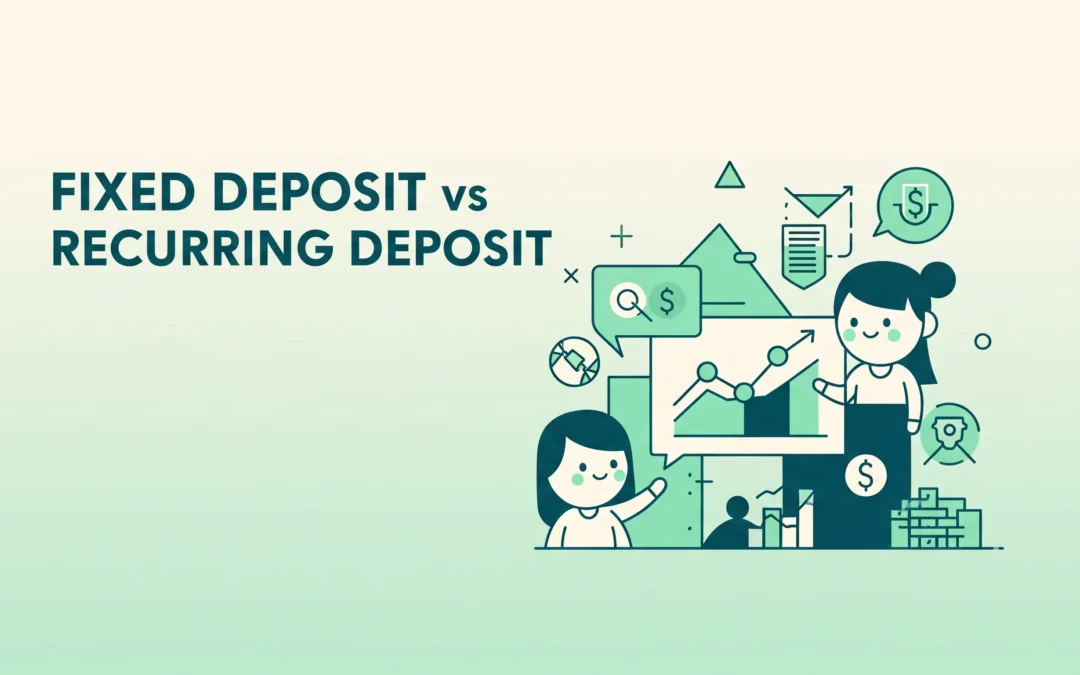FDs are a common investment option in most Indian households. It is considered one of the safest investment options. However, people may confuse a fixed deposit with a recurring deposit. FD and RD are trusted options that help in building a good corpus over time. The structure of both options differs greatly, but both offer guaranteed returns and low risk. There is more to it, like interest payment, flexibility, etc.
This article will explore the key differences between FDs and RDs, along with examples to help you understand the clear distinction between them and help you choose the best.
What is a Fixed Deposit?
A fixed deposit is a way of building a corpus over a longer time period by minimizing the risk. It requires the investor to deposit a large sum of money at a predetermined interest rate, which will remain constant throughout the tenure. It possesses a significantly lower risk and also assures guaranteed returns.
The majority of the Indian population is conservative investors and do not like to take huge risks in terms of savings and building wealth, which makes FDs a widely chosen option.
Characteristics of FDs:
- The minimum amount required to be invested is typically ₹1,000.
- There is flexibility in tenure offered
- Interest rates may vary from bank to bank, typically ranging from 6% to 8%.
- Early withdrawal is permitted, but is subject to a fine
- Up to 90% of the deposit amount may be borrowed against an FD.
Example:
- Principal(p) = ₹1,00,000
- Tenure(n) = 3-year term
- Interest rate = 7.5% annual interest rate
Compounding Frequency(n) = 1 (as it is annually)
Using the formula,
A=P×(1+r/n)^nt
₹1,00,000 × (1.1556) = ₹1,15,562.5
- Amount = ₹1,15,562.5
- Interest = ₹15,562.5 (₹1,15,562.5 – ₹1,00,000)
What is a Recurring Deposit?
A Recurring Deposit (RD) is a method of depositing a principal amount at a regular interval. It is suitable for people who cannot deposit a large sum of money at once. The interest rate is predetermined for the fixed tenure. It is a good choice as it promotes a regular saving habit without blocking a huge capital amount. Let us look at the features of RDs to understand them well.
Characteristics of RDs:
- Investment amount per month is fixed at as little as ₹100 (varies by bank)
- Options for tenure vary from 6 months to 10 years
- Interest rates are typically 5.5% to 7% annually (compound quarterly).
- Early withdrawal is permitted, but interest may be lowered
- It also provides a loan Facility in relation to the RD balance
Assume that for three years, you invest ₹3,000 a month at a 7% annual interest rate that is compounded quarterly in a recurring deposit.
- Monthly Deposit (P) = ₹3,000
- Tenure (t) = 3 years
- Interest Rate = 7% or 0.07
- Quarterly Compounded (n) = 4.
Using this formula,
M=P×{1−(1+r/n) -nt / 1- (1+r/n) −1}/n
M≈ ₹1,60,350
- Total Principal = ₹3,000 × 36 = ₹1,08,000
- Amount = ₹1,60,350
- Interest = (₹1,60,350 − ₹1,08,000) = ₹52,350
Fixed Deposit vs Recurring Deposit
- Interest Rates: Depending on the bank and tenure, FDs typically offer higher interest rates. Since the investment is spread out over time, RDs typically have somewhat lower rates.
- Suitability: FDs are best suited for people with a large sum of spare money available to invest, whereas RDs are preferable for individuals who have a regular saving habit or are salaried employees.
- Interest Payment: Fixed deposits (FDs) can pay interest on a monthly, quarterly, or maturity basis. However, in the case of recurring deposits (RDs), the interest is paid only at maturity.
- Taxation: The interest earned in both situations is subject to taxation under the “Income from Other Sources” heading. If interest surpasses the designated threshold, TDS is applicable.
| Feature | Fixed Deposit (FD) | Recurring Deposit (RD) |
| Investment Type | One-time lump sum | Monthly instalments |
| Tenure | 7 days to 10 years | 6 months to 10 years |
| Interest Rates | 6%–8% (varies by bank & tenure) | Slightly lower than FDs |
| Suitability | For those with a large corpus | For salaried or small savers |
| Interest Payout | Monthly, quarterly, or on maturity | Paid on maturity |
| Taxation | Interest taxable under “Income from Other Sources” | Same as FD |
| Loan Against Deposit | Available | Available (with some limitations) |
Bottomline
The conclusion can be drawn that the majority of Indian investors do not believe in the concept of “quick returns” and prefer FD and RD for long-term deposits. This option provides assured returns with low risk. If the investor has a large sum of spare money that they wish to invest, then a fixed deposit is the right choice. Whereas, if the investor is salaried and has a continuous source of income, then they may prefer a recurring deposit.
Choosing the right option completely depends on the overall financial profile of the individual. Instead of implementing any given advice, the investor must review their risk appetite, source of income, and need for saving to decide the right choice.
Written by: Tanya Kumari


